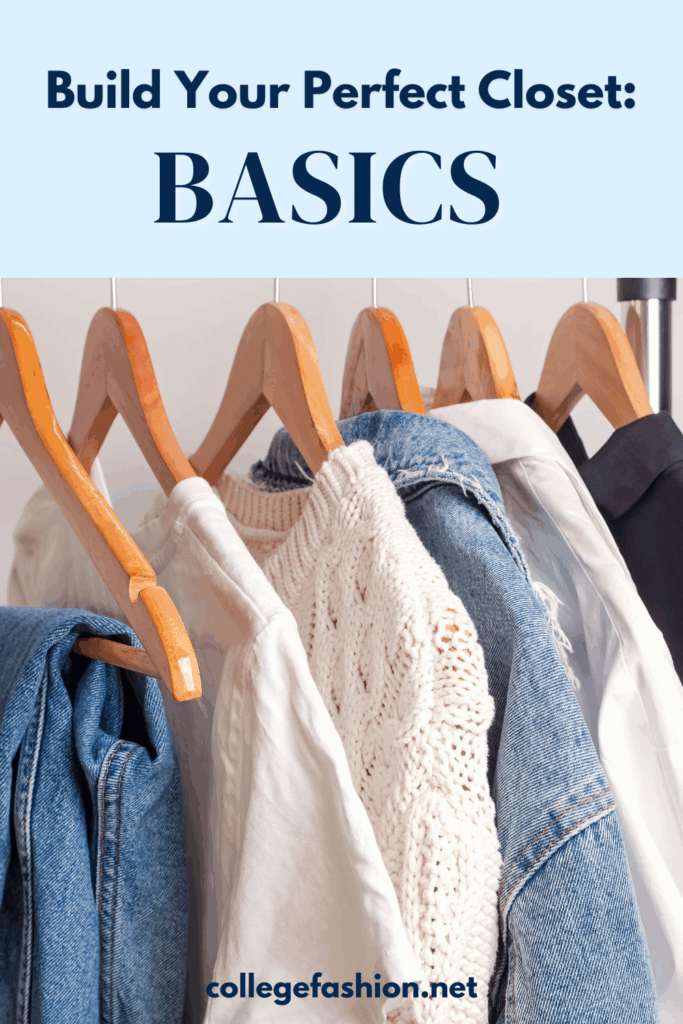
This week, I’m helping you find your basic items to build your perfect closet.
Building the perfect closet is insanely hard. To do it, you have to find items that work for every aspect of your lifestyle, the weather of the place you live in, and that match your personality and taste. There are many lists out there, but how can you know that this list will work for *you*?
In this series, I’ll help you build *your* perfect closet, step by step.
Let’s start with the basics.
We have all seen a list of “must-have” basics in everyone’s closets. This type of list is usually comprised of classic, neutral items, like a white T-shirt, blue jeans, black trousers, and a powder blue button-down.
“They go with everything and everyone.”
But, do they?
When we’re building our closets and figuring out our personal style, we encounter this type of one-size-fits-all sentiment everywhere. But, just like these items, it doesn’t fit us all. Even taking out personal preference, there are a million other factors that affect what works in our closets.
Basics are the base of the style pyramid
Basic items are the foundation of any functional wardrobe. They are supposed to be a bridge between your statement pieces, your style, and your day-to-day activities. Basics help you build outfits easily by seamlessly working with every other item in your closet.
They’re supposed to be the most worn items you have because of their versatility and practicality. So, how do you know which items are *your* basics?
How to Choose Your Basics
Basics vary from person to person, but ask yourself the following questions, and you will find the right path to follow:
- Do they make sense with my lifestyle? – Basics are there to help you on your day to day, so they should be versatile enough to use them year-round, practical to wear for you day-today activities and comfortable for the typical weather where you live.
- Are these the best items I can wear to be comfortable at work or school? – I’m not a fan of dress codes, ideally, we would wear whatever we wanted everywhere without caring, but that’s not the world we live in. And sometimes dress codes do have a purpose, especially if you work or study in a lab, a manufacturing plant, construction sites, or hospitals. Your basics should be appropriate for any activity and make you feel safe and comfortable.
- Can I combine them with most of my closet? – We all love a good pattern or texture, but sometimes combining items can be tricky. Your basics should be able to move seamlessly between items, helping you create outfits with your trickiest items.
- Do I like the color and fit of my basics? – Now, personality. Basics should match your taste and preferences. If you like colors instead of neutrals, then all your basics don’t have to be neutral. If you feel more comfortable wearing loose fitting clothes, then your basics don’t have to be tight-fitting.
Your list of basics should include, at minimum:
- A pair of short-sleeved or sleeveless, simple tops or t-shirts, preferably in solid colors or simple patterns.
- 2 to 3 long-sleeved tops or t-shirts in fabrics that work for your usual weather, in your most worn color, or one that can be combined with it.
- 3 bottoms or 2 bottoms and a dress or jumpsuit, that you feel the most comfortable in.
- 1 layering piece in your most worn color or in a color that can be combined with your most worn color.
Basics 101: A Fashion Guide
Now, the tricky part is figuring out what all these questions look like in your personal style.
Color, prints, and fabrics can and will change depending on your taste and lifestyle. To make this guide as useful as it can be for everyone, I’ll focus on the 7 universal styles introduced by Alyce Parsons.
The seven universal styles are: natural, classic, elegant, romantic, creative, dramatic, and alluring/seductive.
These universal styles are not mutually exclusive, but rather a list of different places we build our personal style from. In general, our personal style is the result of a combination of 2 to 3 of these universal styles, but we pull ideas or references from others for different occasions.
For example, my personal style is mostly a combination of creative, natural, and dramatic, with creative being the main root of my style.
With that in mind, look at the fashion guide below and think which of these styles attracts you the most for yourself. Then, with your main style at hand, see what other styles you can borrow from that also resonate with you and create your own basics mood board.
Table of Contents
Natural – Basic Items
The Natural style is characterized by function and comfort over fashion. It is casual, simple, and approachable. It tends toward relaxed fits, natural fabrics like cotton and denim, and neutral colors in light and medium shades.
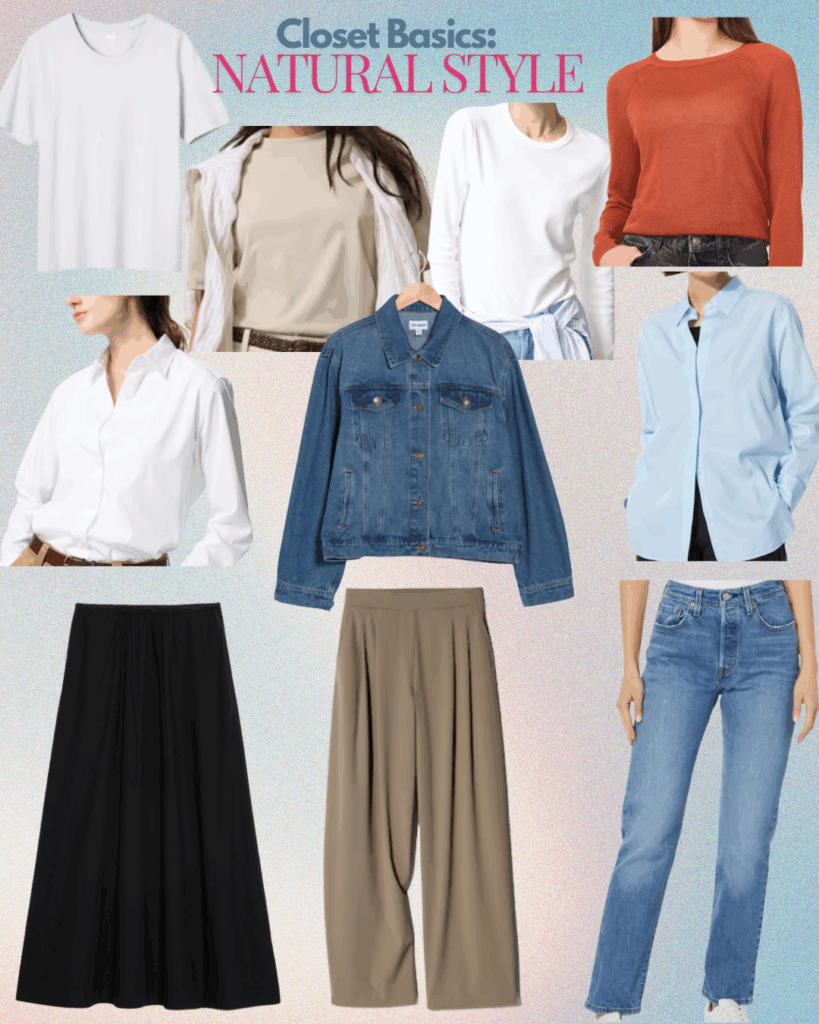
The basic items for a Natural style could be:
- Cotton T-shirts in light neutrals, like white, beige, or grey, and a regular fit.
- Oversized button-down shirts (preferably in cotton, denim, or linen) in light neutrals (like blue, beige, or white).
- Long-sleeved t-shirt or sweater in dark neutrals or rich, earthy tones, like burnt orange.
- Medium wash mom or boyfriend jeans.
- Elasticated cotton pants or trousers (preferably in beige, olive green, or camel)
- Midi or maxi cotton or linen skirt in a darker neutral (preferably navy blue, chocolate brown or black).
- Loose fit denim jacket in a neutral wash (dark blue, black, or white)
Classic – Basic Items
The Classic style is timeless and focuses on traditional items. This style is usually what the “10 must-have Basics” lists are thinking about when talking about what is basic for everyone.
Classic style is tailored but practical, understated and put together. Clean and simple lines, regular fits and a neutral color palette are some fo the main elements for a Classic style.
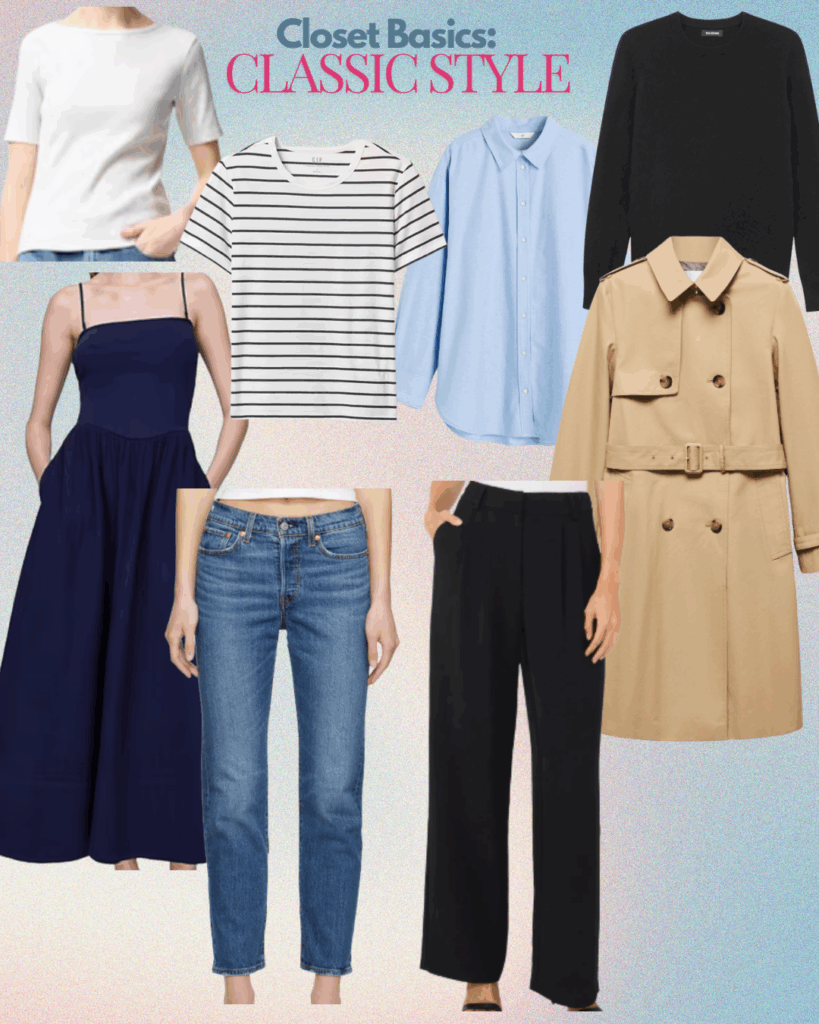
Classic style basics can be:
- Crew neck cotton T-shirt, preferably in an untextured shade like crisp white, black, or navy blue.
- A striped cotton T-shirt in blue and white.
- Powder blue button-up in a classic fit.
- Loose fit (but not oversized) sweater, preferably in navy blue or beige.
- Black tailored trousers, in a regular fit.
- Dark or medium wash straight fit jeans.
- Fit and flare midi dress, preferably in dark neutrals like navy blue or black.
- Beige trench coat (preferably long).
Elegant – Basic Items
The Elegant style is chic, polished and sophisticated. This style looks expensive, put together, and sleek.
The Elegant style uses a lot of tailored pieces, more form-fitting and regular fit items, and monochromatic looks in neutral colors (mostly dark neutrals).
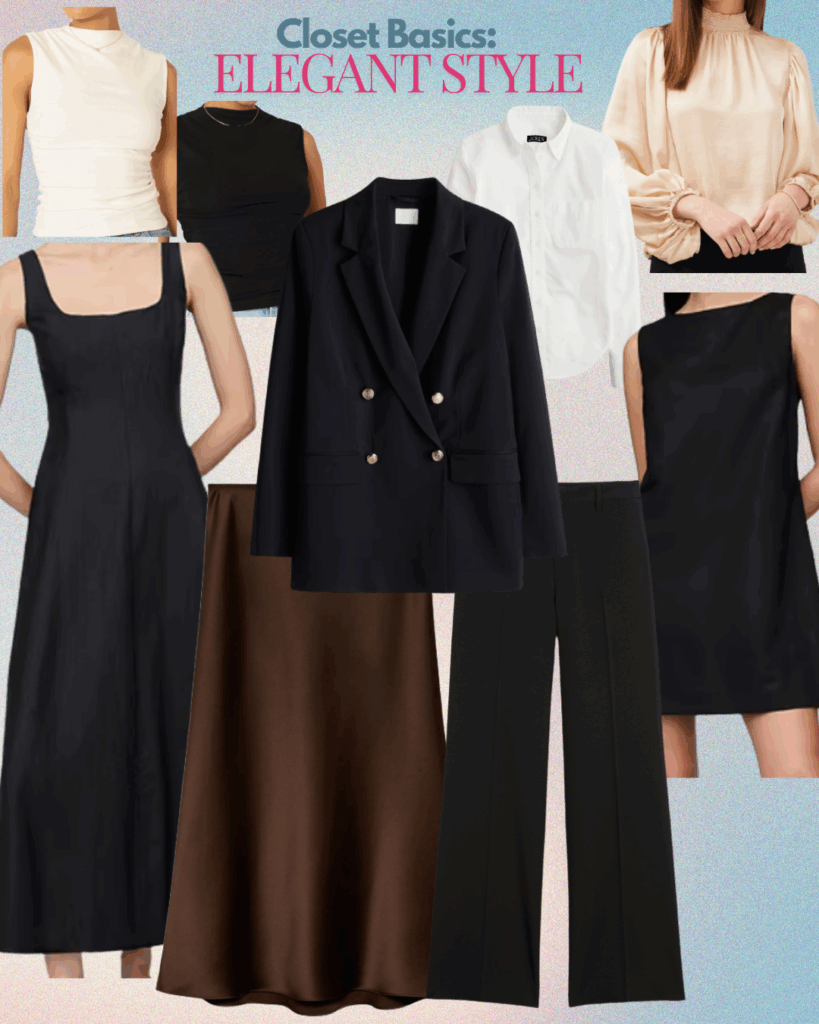
Basic items for this style might be:
- Fitted mock neck sleeveless tops (preferably in black and white).
- Halter sleeveless blouse in satin or silk, preferably in a golden or silver hue.
- Button up shirt in a classic fit, in either cotton, satin, or silk.
- Crew neck blouse in cotton and light neutrals.
- Little black dress
- A-line trousers in a dark neutral like brown or black.
- Subtle A-line or fitted midi skirt, in a neutral color.
- Tailored blazer in a neutral color.
Romantic/Feminine – Basic Items
The Romantic/Feminine style is characterized for its sweetness and softness. This style doesn’t use harsh lines; fabrics are flowy and have a lot of movement.
Romantic style loves details like lace, ruffles, bows and ribbons, and feminine patterns like florals or cute animals. It prefers cotton, tulle, silk or satin, and organza, in light neutrals and pastel colors.
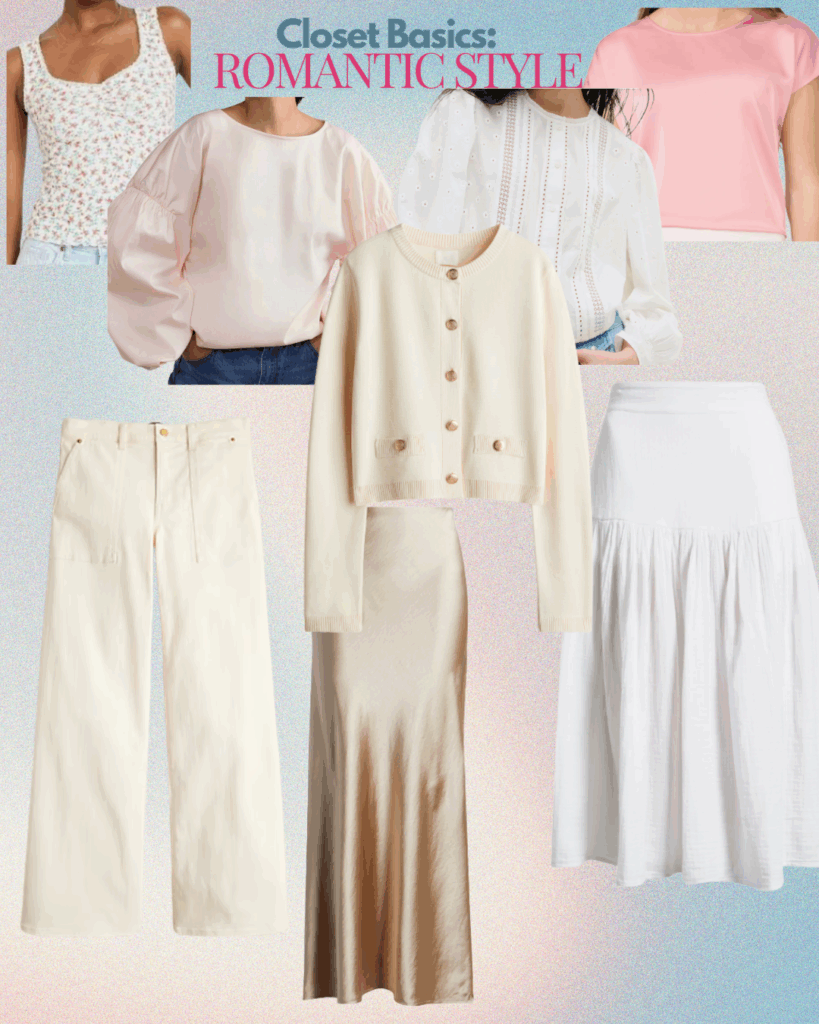
Romantic basics could look like:
- Round or square neck blouses, sleeveless or with short balloon or bell sleeves in light neutrals (white, beige, taupe) or pastels (pink, lilac, baby blue).
- Cotton tank top in light neutrals (white, off white, etc.) or subtle patterns (like small rose bud pattern, little bows, etc.)
- Eyelet (or Broderie anglaise) shirt or blouse in a light neutral or a warm dark neutral (like chocolate brown).
- Long sleeve blouse (balloon or bell sleeves) in a flowy, breathable fabric (linen or cotton) or subtly see-through fabric (organza, mesh) in pastels or a subtle pattern.
- Flowy, silk/satin midi skirt
- White/off-white slightly fitted jeans or trousers.
- A-line cotton midi skirt, in light neutrals.
- Cardigan in medium neutrals (powder blue, grey, or brown) or pastels and a regular fit.
Seductive/Alluring – Basic Items
The Seductive/Alluring style is sexy, eye-catching and glam. This is a bold style, characterized by figure-hugging, plunging necklines or open backs, and dark neutrals or rich, bold colors.
Leather, faux-fur, darker lace, sequins and metallics are some of the textures and fabrics the Seductive style encapsulates.
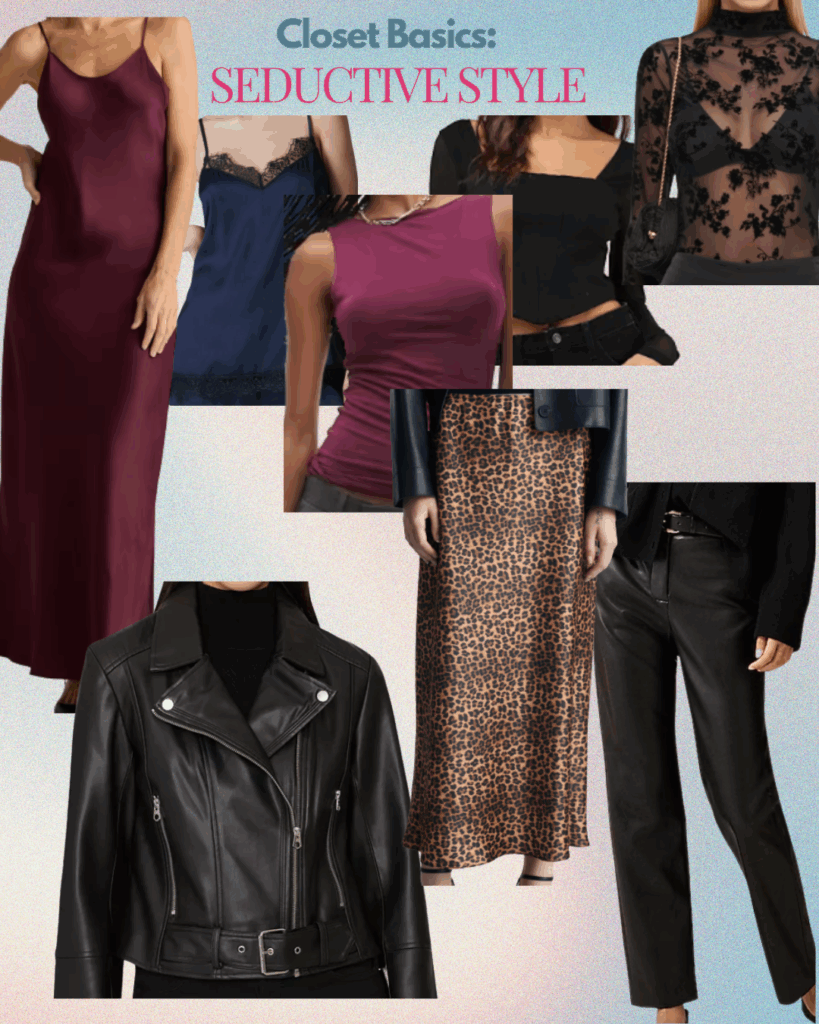
Some of the basic items for a Seductive style could be:
- Camisole in satin/silk and lace details, preferably in a dark neutral like black or a rich bold hue like burgundy.
- Fitted tank top or body suit in a jewel tone color, like burgundy, green, or blue.
- A fitted mesh top, either in a solid dark neutral color or with a nocturnal or gothic pattern.
- Long-sleeved corset top, in a dark neutral or jewel tone color.
- Satin/silk midi/long dress, sleeveless/spaghetti straps, in a dark neutral or a dark shade of red.
- Black leather pants (fitted or regular fit).
- Satin/silk midi skirt, in dark neutrals or animal print.
- Moto jacket (black or metallic)
Creative – Basic Items
The Creative style is eclectic, experimental, and unique. This style is characterized by pattern-mixing, bright colors, vintage or vintage-inspired pieces, and unstructured silhouettes.
A Creative style uses a lot of heavy cotton, denim, metallics, and see-through fabrics like organza. This style leans a lot on patterns, especially polka dots, stripes, geometric prints, plaid, and gingham.
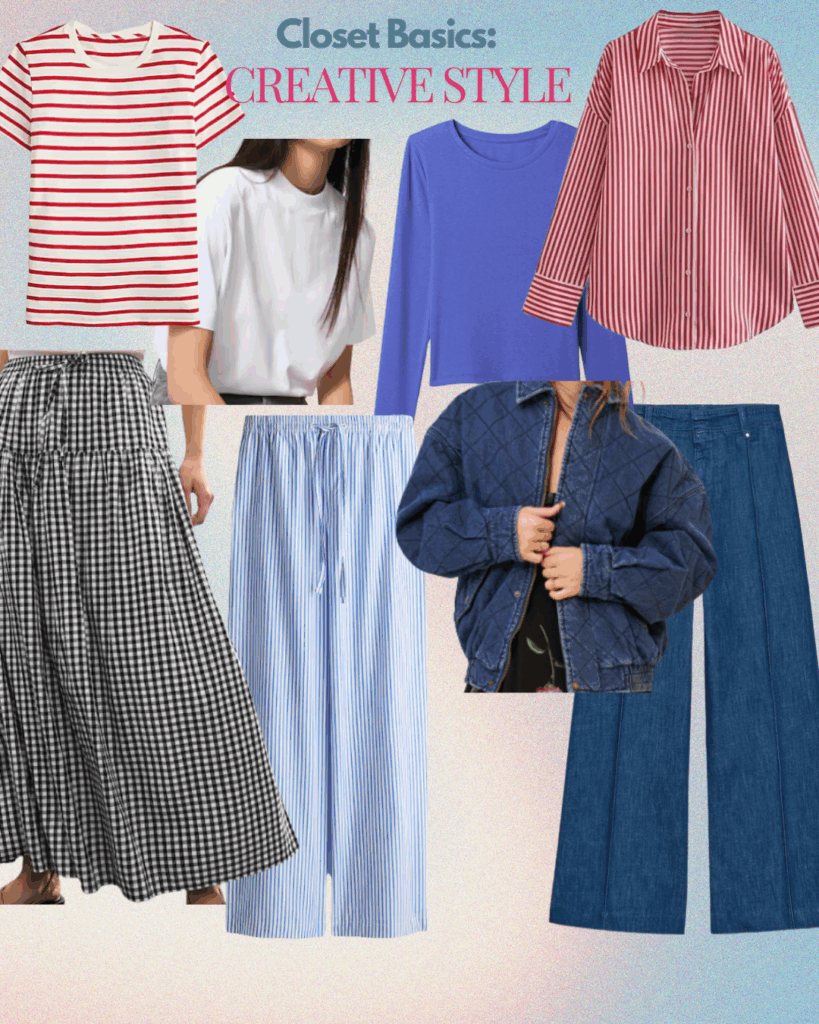
The list of basics for a Creative might be unconventional, but it is one of the best examples of how basics don’t look the same for everyone:
- Stripped crew neck cotton T-shirt, in white and bright-red, blue, or green.
- White crew neck cotton T-shirt, baby tee, or oversized.
- Cotton long-sleeved T-shirt, in a bright/bold color.
- Patterned button down (preferably stripes or polka dots) with a white base and an oversized shape in a non-neutral color.
- Gingham midi/long skirt, preferably in black and white.
- Cobalt blue jeans in a barrel or wide leg fit.
- Elasticated loose-fitting pants, preferably patterned (gingham, stripes, or geometric), and in your most worn bright color.
- Oversized blazer or denim jacket.
Dramatic – Basic Items
Finally, there’s the Dramatic style. Dramatic style is all about statements, architecture, and structure.
Similar to the boldness of the Seductive and the experimental of the Creative, the Dramatic is fashion over function, it is more haute couture than any other.
This style is all about the silhouette and the structure of a garment. Think bold colors, exaggerated details like collars and shoulder pads, geometric lines, and oversized (in hard, clean lines) items.
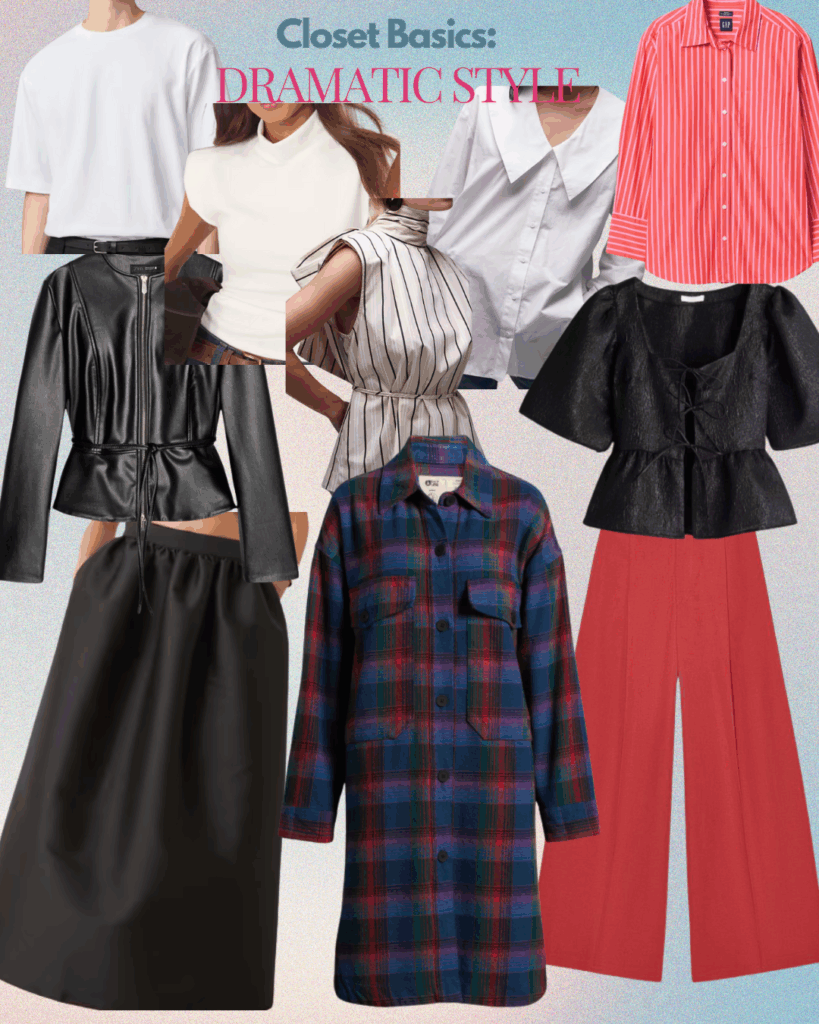
Basic items for a Dramatic style could look like:
- Oversized but structured T-shirt, in crisp white or black.
- High neck or halter sleeveless top, in a rich neutral or geometric pattern.
- Oversized button down with exaggerated details (like a long collar or shoulder pads) or in a bold color that’s either your most worn color or combines with your most worn color.
- A neutral color blouse in a rigid fabric and exaggerated details like balloon sleeves, big bow collar, etc.
- Long, asymmetrical skirt in a rigid fabric.
- Tailored trousers in an exaggerated A-line fit in a bold/rich color.
- Long coat or oversized blazer with exaggerated details.
Final Thoughts
Now that you know what each universal style is all about, you can create your own basics mood board based on the 2 to 3 styles you identify the most.
For example, I mentioned above that my personal style is mostly a combination of creative, natural, and classic.
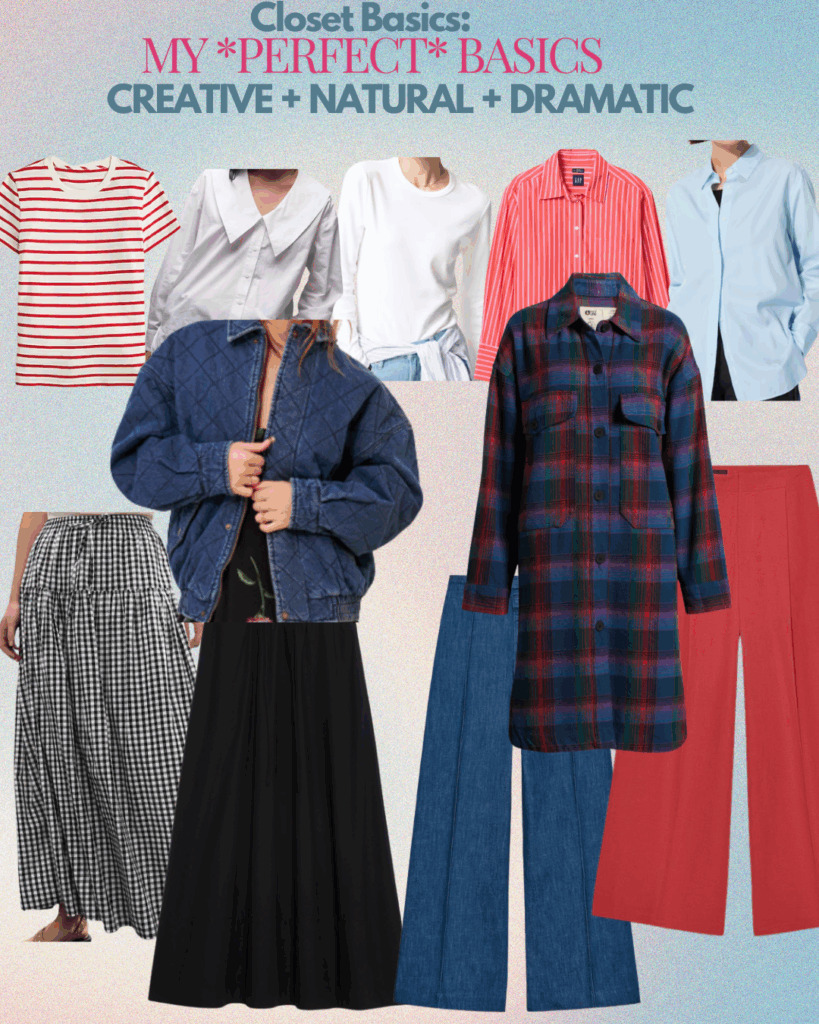
Using the items in the fashion guide above, I created this mood board. As you can see, I pulled different pieces to create *my* ideal basics list.
The priority for me while building an outfit that feels like *me* is to use a lot of patterns and colors, my day-to-day items are in oversized or unstructured silhouettes, and I tend to love more vintage-inspired looks (Creative).
I also prefer to be comfortable and be practical on my day-to-day activities, so relaxed fits and breathable fabrics work the best in my closet, while adding some regular fits here and there allows me to create layered looks (Natural).
Finally, I do have a slight tendency for exaggerated silhouettes, bold colors, and architectural items (Dramatic).
Now, it’s your turn to create your perfect basics list. Remember, these are just the basics, so none of the mood boards look particularly exciting, but this is the foundation on which you will build the rest of your closet. Mix and match the mood boards depending on your activities, weather, and personality.
What Do You Think?
How does your basics’ mood board look like? Which style fits you the most? Do you have any styling or closet questions? Let us know in the comments below!
